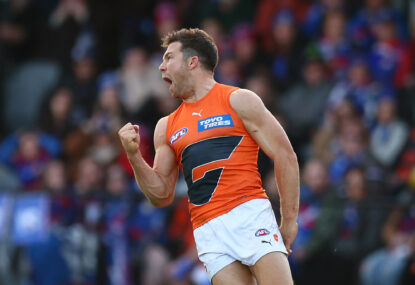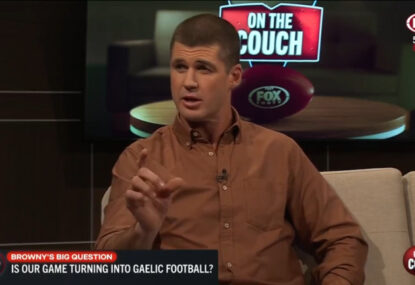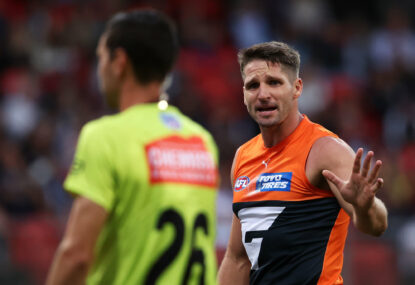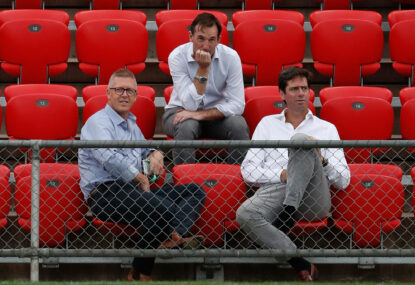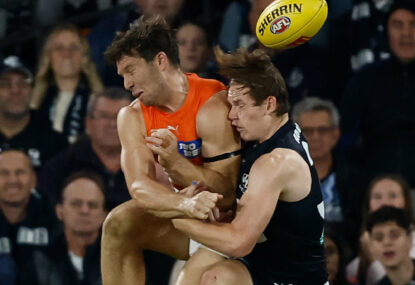The ELO-Following Football rating system covers both teams and individual players, and a couple of weeks ago we looked at the likelihood of team success for each club this year. Today, I intended to go through the ELO-FF rankings from last year and project who the top players will be in 2019.
But the result simply looked wrong.
Last season, Tom Mitchell won the Brownlow. I highly suspect he won’t win it this year. Call it a hunch.
He was only second in our meta-rankings in 2018, however. Max Gawn came out ranked first and Brodie Grundy fourth. Are ruckmen really that valuable? Perhaps, but that’s not how we perceive the game; neither made the top five in The Roar’s Top 50.
Still, height is critical in footy. Proof of this was the failure of Eddie Betts’ indigenous team at AFLX, which had a wide array of talent but no real height to speak of. Even in that bastardised form of the game, they were routed by the more conventionally structured teams.
So, all positions are important, even though we value the ball-handlers and key forwards above backs and ruckmen in our evaluations.
Anyway, rather than try to adapt the meta-scores from the 2018 season, I’m trying something different. I’ve taken the ratings of the 50 best players from several sources, including The Roar’s series that came out last week and our own Following Football 2018 meta-scores, along with other organisational rankings (no civilians allowed this time!) from the end of last season and now.
Then, rather than add up point totals or the like, I categorised players by “consensus rankings”. For example, the three players in Category A could be placed in any order depending on your taste, but everyone agrees that they’re all top five players.
More importantly, nobody else fits that consensus, so those three players are ranked together in the top three. I believe it’s unimportant which one is the best, because what matters is that each of them is a generational player who is always going to be the best player on the field – unless they’re playing each other.
As we move through the categories, the consensus might be top ten, fifteen, 28, 40, 65, or anything else in between. But the categories are in order: the players in category C are generally conceded to be better than the players in category D, and so forth. There’s also no intent to designate any player in a category to be better than anyone else within the same category.
And as always, the exercise in ranking a player’s worth is fundamentally useless because what matters is what they do on the field this year and beyond.
I guarantee someone we don’t list here will be widely recognised as top 20 or better at the end of the year, and that someone in the top few categories will hit a wall and become so much dead wood on their team’s roster too suddenly for our taste as fans.
So the only valid purpose of any such ranking is to facilitate conversation – therefore, please, have fun shuffling names in the comments. Just be polite about it, kids!
Category A
Patrick Dangerfield (Geelong), Nat Fyfe (Fremantle), and Dustin Martin (Richmond).

Patrick Dangerfield. (Photo by Michael Dodge/Getty Images)
Inarguably the three best players in footy today. All are at their peak powers in 2019, every one of them a consummate ball-handler and equally deft at scoring and a half-dozen other essential skills. If you’re starting a team, you could take any one of them and you’d have a firm foundation for the next five years. (Ranks No.1-3, in whatever order you personally want to place them.)
Category B
Lance Franklin (Sydney).
I know, I always think Buddy’s in a class by himself. Because of his injuries recently, Franklin is no longer quite a consensus top five player – but there’s no question that he’s still uniquely skilled and has a few more years of immense value remaining. He’s constantly listed as the best if he’s fully healthy. So maybe “Category A½” would be a better title. (Rank No.4)
Category C
Patrick Cripps (Carlton), Josh Kelly (GWS), and Alex Rance (Richmond).
All three are top twelve in every evaluation, and all three spark arguments that either they should be higher or shouldn’t be this high in 2019. Perfect. Here they are, together. (Ranks No.5-7)
Category D
Marcus Bontempelli (Western Bulldogs), Tom Mitchell (Hawthorn), and Rory Sloane (Adelaide).
All are top 20, probably top 15, but not likely to be above sixth or so. All are tremendous players without that indefinable “je ne sais quoi” that keep them from being at the very top. (Ranks No.8-10)
Category E
Max Gawn (Melbourne), Robbie Gray (Port Adelaide), Jeremy McGovern (West Coast), and Clayton Oliver (Melbourne).

Max Gawn of the Demons in action. (Photo by Michael Willson/AFL Media/Getty Images)
Universally top 25. They might show up at the bottom of some top ten lists, but they’re not falling below 25 for anyone. To me, it seems the two Demons should be ranked above the other two, but there are some evaluators who disagree with my opinion. So, they fall together in this grouping. (Ranks No.11-14)
Category F
Dayne Beams (Collingwood), Brodie Grundy (Collingwood), Scott Pendlebury (Collingwood), and Elliot Yeo (West Coast).
The Magpie category, apparently. I think all these players are top 25, too, but not every ranking does. Beams now slides into a team where there are four or five other players at right about his level of excellence – it’s going to be an interesting change for him! (Ranks No/15-18)
Category G
Steele Sidebottom (Collingwood), Callan Ward (GWS), and Dayne Zorko (Brisbane).
This group of players, I believe, share the trait of often being ignored by the folks who don’t pay enough attention to the intricacies of the sport to realise they’re elite. Sidebottom had his best season of the last five, almost out of nowhere, lurking in the Pendle-shadow; Ward and Zorko are shrouded by their consistency and playing away from Victoria. (Ranks No.19-21)
Category H
Stephen Coniglio (GWS), Andrew Gaff (West Coast), Toby Greene (GWS), Josh J Kennedy (West Coast), Jack Riewoldt (Richmond), and Joel Selwood (Geelong).
Now the groupings start to get bigger. Every one of these players is clearly a top 40 guy, but it’s easy to argue some of them could or should be much higher.
Kennedy and Greene have been held back by recent injury; Riewoldt and Selwood are approaching the “sage” end of their careers; Gaff is still on the way up after a brain-fade interruption last year. Only Coniglio is arguably topping out here, although he’s a personal favourite of mine. (Ranks No.22-27)
Category I
Ben Brown (North Melbourne), Trent Cotchin (Richmond), Jordan de Goey (Collingwood), Tom Hawkins (Geelong), Isaac Heeney (Sydney), Tim Kelly (Geelong), Rory Laird (Adelaide), and Lachie Whitfield (GWS).

Ben Brown. (Photo by Quinn Rooney/Getty Images)
What do these eight men have in common? You’d take any of them on your team in a heartbeat, for one thing. Nobody leaves any of them off their top 50 list, for another, and nobody’s got any of them pushing for anything higher than number 20 or so. Ma-aybe 15th. (Ranks No.28-35)
Category J
Gary Ablett (Geelong), Jeremy Cameron (GWS), Joe Daniher (Essendon), Jack Darling (West Coast), Jack Gunston (Hawthorn), Shaun Higgins (North Melbourne), Tom Lynch (Richmond), Jackson Macrae (Western Bulldogs), Dylan Shiel (Essendon), and Adam Treloar (Collingwood).
My impression is that this is the list of names you reach for to fill out the bottom of your top 50 when you find you’re still a few names short of completion. Every one of them is valuable to your team, but if they’re your best player, you’re not going to compete with the big boys in 2019.
Some, like the Little Master, are falling through the rankings as they reach the end of their illustrious careers. Some, like Macrae, are just starting their rise into the upper echelons of the league. Some have had injury issues, like Daniher or Darling, that have kept them from higher placements.
Some still have something to prove to the league (here’s looking at you, Mr Lynch). (Ranks No.36-45)
Category K Harris Andrews (Brisbane), Ben Cunnington (North Melbourne), Michael Hurley (Essendon), Josh P Kennedy (Sydney), Jake Lloyd (Sydney), Tom McDonald (Melbourne), Luke Shuey (West Coast), James Sicily (Hawthorn), and Jack Steven (St Kilda).
Finally, we’ve entered the territory where not everyone thinks they’re top 50 players – in fact, at this point, Category K leaks down below that number 50 slot. But it’s impossible to deny that each of these players is outstanding: many are defenders who don’t get the recognition they deserve.
I guarantee if any of them came to play at your club, they’d be welcomed into the line-up on day one with open arms! (Ranks No.46-54)
Category X Let me list 25 more names that showed up in some Top 50s but not others. I suspect some are “just really good players” that you might look at and wonder why I bothered to mention them, and others that you’ll defend to the death as an absolute requirement for any intelligent viewer to include.
Again, play nice in the comments, please!
Adelaide: Eddie Betts, Matt Crouch, Bryce Gibbs. Brisbane: Lachie Neale. Carlton: Charlie Curnow. Essendon: Dyson Heppell, Zach Merrett, Devon Smith. Fremantle: Brad Hill, Jesse Hogan. Geelong: Mitch Duncan. Hawthorn: Luke Breust, Shaun Burgoyne. Melbourne: Angus Brayshaw, Jack Viney. Port Adelaide: Ollie Wines, Paddy Ryder. Richmond: Josh Caddy, Shane Edwards, Daniel Rioli. St Kilda: Seb Ross. Sydney: Luke Parker, Dane Rampe. West Coast: Shannon Hurn, Nic Naitanui.
Now, feel free to tell us how far off so-and-so from your favourite team is. But let me forewarn you: this isn’t my list. It’s just the consensus of others.
If you’re curious how this list stacks up team by team.
Adelaide: Categories D, I, X, X, X. (2 top 54, 3 honorable mention)
Brisbane: Categories G, K, X. (2, 1)
Carlton: Categories C, X. (1, 1)
Collingwood: Categories F, F, F, G, I, J. (6, 0)
Essendon: Categories J, J, K, X, X, X. (3, 3)
Fremantle: Categories A, X, X. (1, 2)
Geelong: Categories A, H, I, I, J, X. (5, 1)
Gold Coast: None. (0, 0)
GWS Giants: Categories C, G, H, H, I, J. (6, 0)
Hawthorn: Categories D, J, K, X, X. (3, 2)
Melbourne: Categories E, E, K, X, X. (3, 2)
North Melbourne: Categories I, J, K. (3, 0)
Port Adelaide: Categories E, X, X. (1, 2)
Richmond: Categories A, C, H, I, J, X, X, X. (5, 3)
St Kilda: Categories K, X. (1, 1)
Sydney: Categories B, I, K, K, X, X. (4, 2)
West Coast: Categories E, F, H, H, J, K, X, X. (6, 2)
Western Bulldogs: Categories D, J. (2, 0)
Looking at this list, it’s pretty easy to line up the top player lists alongside the general consensus 2019 rankings and see the convergence.
West Coast, Richmond: eight players in this top 79.
Collingwood, GWS, Geelong, Sydney, Essendon: six.
Melbourne, Hawthorn*, Adelaide: five.
North Melbourne, Brisbane, Port Adelaide, Fremantle: three.
Western Bulldogs, St Kilda, Carlton: two.
Gold Coast: zero
*includes Tom Mitchell, who won’t play in 2019.
Make of that as you will. But ten teams have at least five players recognised as elite; eight others (none of which made finals last year) have three or fewer.
Does that seem like there’s a correlation? It does to me.
Gold Coast is expected to finish last; with no players in the top eighty, is that such a weird prediction? Not at all.
The four teams with just three players are all generally considered “borderline” finals candidates. Coincidence? No.
West Coast and Richmond are the two with the most elite players – is it so strange to think of them as the two favourites this season? I don’t think so.
































































































